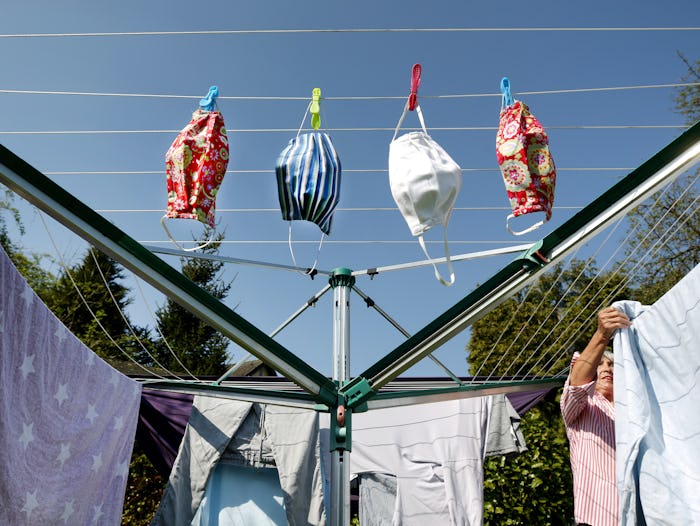Life

Here's What You Need To Know About Drying Your Cloth Face Masks
By now, you probably have a small collection of face masks to help slow the spread of COVID-19. But like anything else, they have to be properly taken care of in order to do that. While figuring out how to properly store and disinfect your masks, you'll also want to know how to dry face masks without shrinking or ruining them.
First: it's important to note that there's nothing wrong with reusing a cloth face mask. Dr. Mitch Li, an emergency physician, tells Romper, "I tell patients to think of masks like they do underwear. While it's true that underwear gets dirty, that's no reason to stop wearing it. Just wash them." Ideally, you should wash your cloth face mask after every single wear, but if that's not possible, then wash it every few wears.
How you wash a face mask really depends on what it's made out of and where it's from. If you've purchased a cloth face mask, be sure to check the laundry instructions to see exactly how to clean it. Many masks are able to be thrown into the washing machine, which is super convenient. Some are hand-wash only, though, so be mindful of that. Whether you're throwing them in the washing machine or hand-washing them, Li says that regular laundry detergent is a great way to clean them. "Aside from washing the virus — or any other germs — away, laundry detergent can actually break up the lipid bilayer of the virus, and effectively 'kill' it," he says. "Cloth masks can be washed to manufacturer recommendations just like we would wash underwear."
He also recommends washing your masks at the maximum temperature possible. "The WHO recommends a temperature between 140 and 194 degrees Fahrenheit. Research from Stanford suggests that COVID cannot stand temperatures greater than 158 degrees Fahrenheit for 30 minutes — though this was conducted in a hot air oven. The problems with this approach are the same one could expect with any item of clothing, such as shrinking of the item and fewer washes before the item degrades."
Li also says that drying your face masks is pretty easy as well and also dependent on the specific laundry instructions for your mask. Most masks can be thrown in the dryer at the highest setting. And, according to the CDC, you should "use the highest heat setting and leave in the dryer until completely dry."
If you don't have a dryer or don't want to use one, the CDC says that you can dry your face mask by laying it out flat and allowing it to dry completely, adding, "If possible, place the mask in direct sunlight." There is some evidence that light kills the coronavirus faster.
If you're using an N95 medical face mask, remember that these need to be cared for differently. "There have been many discussions on how to safely reuse N95s, which are supposed to be disposable," says Li. "Compared to a cloth mask, an N95 is made up of fibers that would be physically broken down by a wash cycle rendering the mask ineffective in terms of functioning as a respirator." According to Li, many hospitals are trying to "clean" their N95s by heating them, exposing them to UV lights, or spraying them down with hydrogen peroxide. Before you try this at home, though, he points out that "all of these approaches have drawbacks as they can also decrease the integrity of the mask."
The CDC notes that N95 masks should be worn a limited amount of times, and that some of these masks aren't cleared to be reusable at all. If you want to try to extend the life of your N95, the CDC recommends wearing a cloth face mask over the respirator mask to keep it cleaner. You should hang it when you're not wearing it, or keep it in a breathable container. "In my hospital, we took the much simpler approach of 'cycling through' our masks so that the mask would sit in a paper bag for about three to four days between uses," Li says. "This is a low-cost solution as research has shown that COVID-19 viral particles can persist on smooth surfaces for days, but seem to die sooner on porous surfaces such as cardboard."
Once your face mask is completely dry, it's safe to use again. But, in the meantime, be sure to store your face mask in a place where it won't get contaminated in between wears. Instead of throwing your face mask in your bag or leaving it laying out on the kitchen counter, store it in a small plastic bag on its own, or leave it hanging by the ear loop on a door. If it's in the sun, that's even better. Personally, I hang my face mask by the front door so I can always remember to take it with me.
Keep your face mask clean and dry by removing it properly, and wash or sanitize your hands before you take off your face mask. The CDC says to only remove it by touching the ear loops instead of the cloth part. Once the mask is off, avoid touching your nose, mouth, or eyes until you have thoroughly washed your hands.
Expert:
Dr. Mitch Li, a practicing Board-Certified Emergency Physician and Owner/Medical Director at Thrive Direct Care